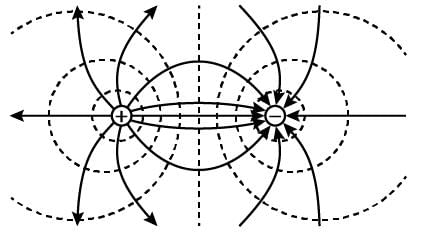Assertion & Reason Test: Electrostatic Potential & Capacitance - 2 - NEET MCQ
15 Questions MCQ Test Topic-wise MCQ Tests for NEET - Assertion & Reason Test: Electrostatic Potential & Capacitance - 2
Directions: In the following questions, A statement of Assertion (A) is followed by a statement of Reason (R). Mark the correct choice as.
Assertion (A): Electric field inside a hollow conducting sphere is zero.
Reason (R): Charge is present on the surface of the conductor.
Directions: In the following questions, A statement of Assertion (A) is followed by a statement of Reason (R). Mark the correct choice as.
Assertion (A): Electric potential and electric potential energy are two different quantities.
Reason (R): For a test charge Q and a point charge Q, the electric potential energy becomes equal to the potential.
Directions: In the following questions, A statement of Assertion (A) is followed by a statement of Reason (R). Mark the correct choice as.
Assertion (A): Circuit containing capacitors should be handled very carefully even when the power is off.
Reason (R): The capacitors may break down at any time.
Directions: In the following questions, A statement of Assertion (A) is followed by a statement of Reason (R). Mark the correct choice as.
Assertion (A): Two parallel metal plates having charge +Q and –Q are facing at a distance between them. The plates are now immersed in kerosene oil and the electric potential between the plates decreases.
Reason (R): Dielectric constant of kerosene oil is less than 1.
Directions: These questions consist of two statements, each printed as Assertion and Reason. While answering these questions, you are required to choose any one of the following four responses.
Assertion : A parallel plate capacitor is connected across the battery through a key. A dielectric slab of dielectric constant K is introduced between the plates. The energy which is stored becomes K times.
Reason : The surface density of charge on the plate remains constant or unchanged.
Directions: These questions consist of two statements, each printed as Assertion and Reason. While answering these questions, you are required to choose any one of the following four responses.
Assertion : The electrostatic force between the plates of a charged isolated capacitor decreases when dielectric fills whole space between plates.
Reason : The electric field between the plates of a charged isolated capacitance increases when dielectric fills whole space between plates.
Directions: These questions consist of two statements, each printed as Assertion and Reason. While answering these questions, you are required to choose any one of the following four responses.
Assertion : Two equipotential surfaces cannot cut each other.
Reason : Two equipotential surfaces are parallel to each other.
Directions: These questions consist of two statements, each printed as Assertion and Reason. While answering these questions, you are required to choose any one of the following four responses.
Assertion : Electric field inside a conductor is zero.
Reason: The potential at all the points inside a conductor is the same.
Directions: These questions consist of two statements, each printed as Assertion and Reason. While answering these questions, you are required to choose any one of the following four responses.
Assertion : Work done in moving a charge between any two points in an electric field is independent of the path followed by the charge, between these points.
Reason: Electrostatic force is a non conservative force.
Directions: These questions consist of two statements, each printed as Assertion and Reason. While answering these questions, you are required to choose any one of the following four responses.
Assertion : Electric potential and electric potential energy are different quantities.
Reason : For a system of positive test charge and point charge electric potential energy = electric potential.
Directions: These questions consist of two statements, each printed as Assertion and Reason. While answering these questions, you are required to choose any one of the following four responses.
Assertion : For a charged particle moving from point P to point Q, the net work done by an electrostatic field on the particle is independent of the path connecting point P to point Q.
Reason : The net work done by a conservative force on an object moving along a closed loop is zero.
Directions: These questions consist of two statements, each printed as Assertion and Reason. While answering these questions, you are required to choose any one of the following four responses.
Assertion : Dielectric polarisation means formation of positive and negative charges inside the dielectric.
Reason: Free electrons are formed in this process.
Directions: These questions consist of two statements, each printed as Assertion and Reason. While answering these questions, you are required to choose any one of the following four responses.
Assertion : For a point charge, concentric spheres centered at a location of the charge are equipotential surfaces.
Reason : An equipotential surface is a surface over which potential has zero value.
Directions: These questions consist of two statements, each printed as Assertion and Reason. While answering these questions, you are required to choose any one of the following four responses.
Assertion : Two equipotential surfaces cannot cut each other.
Reason : Two equipotential surfaces are parallel to each other.
Directions: These questions consist of two statements, each printed as Assertion and Reason. While answering these questions, you are required to choose any one of the following four responses.
Assertion: The equatorial plane of a dipole is an equipotential surface.
Reason: The electric potential at any point on the equatorial plane is zero.
|
9 docs|1259 tests
|





















